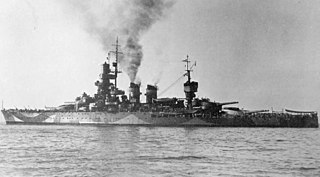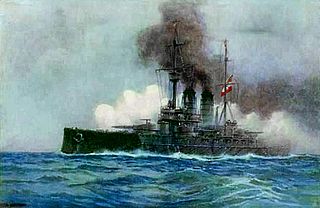See also
- Andrea Doria-classbattleship (1910s–1950s)
- Andrea Doria-classcruiser (1960s–1990s)
Andrea Doria has been borne by five ships of the Italian military and merchant navy, after Andrea Doria and may refer to:

A battleship is a large armored warship with a main battery consisting of large caliber guns. It dominated naval warfare in the late 19th and early 20th centuries.

Pre-dreadnought battleships were sea-going battleships built between the mid- to late- 1880s and 1905, before the launch of HMS Dreadnought in 1906. The pre-dreadnought ships replaced the ironclad battleships of the 1870s and 1880s. Built from steel, protected by case-hardened steel armour, and powered by coal-fired triple-expansion steam engines, pre-dreadnought battleships carried a main battery of very heavy guns in fully-enclosed rotating turrets supported by one or more secondary batteries of lighter weapons.

The Regia Marina was the navy of the Kingdom of Italy from 1861 to 1946. In 1946, with the birth of the Italian Republic, the Regia Marina changed its name to Marina Militare.

Duilio was an Italian Andrea Doria-class battleship that served in the Regia Marina during World War I and World War II. She was named after the Roman fleet commander Gaius Duilius. Duilio was laid down in February 1912, launched in April 1913, and completed in May 1916. She was initially armed with a main battery of thirteen 305 mm (12.0 in) guns, but a major reconstruction in the late 1930s replaced these with ten 320 mm (13 in) guns. Duilio saw no action during World War I owing to the inactivity of the Austro-Hungarian fleet during the conflict. She cruised the Mediterranean in the 1920s and was involved in the Corfu incident in 1923.

Vittorio Veneto was a helicopter cruiser that served with the Italian Navy. Originally intended to be a class of two ships specifically designed for anti-submarine warfare (ASW), only Vittorio Veneto entered into service in 1969, its sister ship Italia being cancelled. Vittorio Veneto was decommissioned in 2003. This ship has the same general layout as the smaller Andrea Doria-class helicopter cruisers, but with two elevators in the flight deck and the hangar below, rather than with the hangar as part of the superstructure. It was named for the decisive Battle of Vittorio Veneto which ended World War I on the Italian front.

There was sporadic naval warfare in the Mediterranean during World War I between the Central Powers' navies of Austria-Hungary, Germany and the Ottoman Empire and the Allied navies of Italy, France, Greece, Japan, America and the British Empire.

The Andrea Doria class was a pair of dreadnought battleships built for the Royal Italian Navy between 1912 and 1916. The two ships—Andrea Doria and Duilio—were completed during World War I. The class was an incremental improvement over the preceding Conte di Cavour class. Like the earlier ships, Andrea Doria and Duilio were armed with a main battery of thirteen 305-millimeter (12.0 in) guns.

Andrea Doria was the lead ship of her class of battleships built by the Regia Marina. The class included only one sister ship, Duilio. Andrea Doria was named after the 16th-century Genoese admiral of the same name. Laid down in March 1912, the battleship was launched a year later in March 1913, and completed in March 1916. She was armed with a main battery of thirteen 305 mm (12.0 in) guns and had a top speed of 21 knots.
Andrea Doria (1466–1560) was an Italian (Genoese) admiral.

SMS Erzherzog Franz Ferdinand was an Austro-Hungarian Radetzky-class pre-dreadnought battleship commissioned into the Austro-Hungarian Navy on 5 June 1910. She was named after Archduke Franz Ferdinand. The first ship of her class to be built, she preceded Radetzky by more than six months. Her armament included four 30.5 cm (12 in) guns in two twin turrets, and eight 24 cm (9.4 in) guns in four twin turrets.

Re Umberto was a Re Umberto-class ironclad battleship built for the Italian Regia Marina in the 1880s, the lead ship of her class. She was laid down in July 1884 and launched in October 1888; work proceeded so slowly that she was not finished until February 1893. She was armed with a main battery of four 13.5-inch (340 mm) guns and had a top speed of 20.3 knots, though this high speed came at the cost of armor protection.

Vittorio Emanuele was an Italian pre-dreadnought battleship, laid down in 1901, launched in 1904 and completed in 1908. She was the second member of the Regina Elena class, which included three other vessels: Regina Elena, Napoli, and Roma. Vittorio Emmanuele was armed with a main battery of two 12 in (305 mm) guns and twelve 8 in (203 mm) guns. She was quite fast for the period, with a top speed of nearly 21 knots.

Ruggiero di Lauria was an ironclad battleship built in the 1880s for the Italian Regia Marina. She was the lead ship of the Ruggiero di Lauria class, which included two other ships, Francesco Morosini and Andrea Doria. Ruggiero di Lauria, named for the medieval Sicilian admiral Ruggiero di Lauria, was armed with a main battery of four 17-inch (432 mm) guns, was protected with 17.75-inch (451 mm) thick belt armor, and was capable of a top speed of 17 knots.

Andrea Doria was an ironclad battleship built for the Italian Regia Marina in the 1880s and 1890s. Named for the 16th-century Genoese admiral Andrea Doria, she was the third and final ship of the Ruggiero di Lauria class. The ship was armed with a main battery of four 17-inch (432 mm) guns, was protected with 17.75-inch (451 mm) thick belt armor, and was capable of a top speed of 17 knots.
Four ships of the Regia Marina, and the present day Italian Navy, have borne the name Duilio or Caio Duilio, the name commemorating the 3rd century BC Roman naval leader Gaius Duilius:

A naval arms race among Argentina, Brazil and Chile—the most powerful and wealthy countries in South America—began in the early twentieth century when the Brazilian government ordered three dreadnoughts, formidable battleships whose capabilities far outstripped older vessels in the world's navies.

Quarto was a unique protected cruiser built by the Italian Regia Marina in the 1910s. Her keel was laid in November 1909, she was launched in August 1911, and was completed in March 1913. She was the first Italian cruiser to be equipped with steam turbines, which gave her a top speed of 28 knots. Her high speed was a requirement for the role in which she was designed to serve: a scout for the main Italian fleet.

The Cannon 76/40 Model 1916 was a widely used naval gun on ships of the Royal Italian Navy during World War I and World War II. A very versatile weapon it was used as primary, secondary and tertiary armament on a number of ship classes. After being replaced aboard ships of the Royal Italian Navy it saw widespread use on land in a number of different roles such as coastal artillery, anti-aircraft gun and railroad gun during World War II.